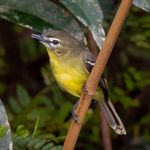AMAZON VISION SUMMARY - US Agency for International ...
←
→
Page content transcription
If your browser does not render page correctly, please read the page content below
AMAZON VISION SUMMARY
The United States Agency for International Development (USAID) developed the Amazon Vision in 2016
to be the framework unifying the Agency’s goals across the region. This Vision provides a coordinated
and strategic regional response to threats facing the Amazon forest in Brazil, Colombia, Ecuador, Guyana,
Peru, and Suriname. It describes, guides, and measures USAID’s investments and conservation impact at a
regional scale and includes the work of the Amazon Regional Environmental Program (AREP), the bilateral
Missions, and USAID/Washington projects in the Amazon.
A healthy and resilient Amazon
Basin that is valued by society,
ensures human well-being, and
safeguards our global climate.USAID’s Amazon Vision has four overarching goals:
1. Decrease deforestation, forest degradation, and greenhouse gas emissions
2. Foster an environmentally friendly economy
3. Protect key landscapes and species
4. Secure the rights, resources, and health of forest-dependent communities
This is a summary of the 2020 Amazon Vision Report [insert link here?]. It describes the regional context,
the current status, and illustrative achievements of USAID’s biodiversity and sustainable landscape initia-
tives in the Amazon basin through the lens of this Vision.
ACTIONS AND ACHIEVEMENTS IN THE
AMAZON
In the Amazon basin countries of Brazil, Colombia, Ecuador,
Guyana, Peru, and Suriname, USAID is supporting projects
that combat deforestation, conserve biodiversity, create
environmentally-friendly economic opportunities, improve
the management of important landscapes, and support
Indigenous rights.
Building on a long history of partnership in the region, USAID
assistance is showing results for both the environment and
the people who rely on it. For the period of 2015–2024,
Macaws, Napo River, Ecuador. Credit: USAID has committed approximately $257 million for the
Julie Larsen Maher,Wildlife implementation of activities in the region, where it has historically
Conservation Society been one of the five largest conservation donors.
2020 USAID INVESTMENT IN THE AMAZON REGION
Approximately $257 Improved economic benefits
million committed for the gained by more than 87,000
implementation of USAID people
activities from 2015-2024
Land management improved in
nearly 48 million hectares
Estimated 38.5 million
metric tons of CO2 avoided,
sequestered, or reduced—the
equivalent of 4.4 million U.S. $21 million of private sector
homes’ energy use for one year funding leveraged by USAID
AMAZON VISION SUMMARY | 2SUCCESS STORIES
GOAL 1: DECREASE DEFORESTATION, FOREST DEGRADATION, AND
GREENHOUSE GAS EMISSIONS
CINCIA Innovation Lab, Peru
USAID, in partnership with Wake Forest University’s Center for
Amazonian Scientific Innovation (CINCIA), works to restore
lands decimated by illegal gold mining and support local
communities affected by mercury poisoning. In a 42-hectare
forest laboratory, CINCIA scientists are testing 75 native
species in degraded soils collected from mining sites. The
heartiest and quickest-growing are selected to reforest
former mining sites in the Peruvian Amazon. The laboratory
is also researching the use of cutting-edge organic fertilizers
that bring nutrients back to degraded soils and accelerate
reforestation. In addition to its reforestation efforts, CINCIA
is researching mercury-free mining alternatives and mercury CINCIA uses drones to improve the
analysis of deforested mining areas.
mitigation, and using drone monitoring technology and improved Credit: Jason Houston for
mine closure techniques. CINCIA
GOAL 2: FOSTER AN ENVIRONMENTALLY FRIENDLY ECONOMY
Partnership Platform for the Amazon, Brazil
USAID catalyzed the creation of the Partnership Platform for
the Amazon (PPA) to promote an innovative development
model by supporting Amazonian entrepreneurs with a vision
for a sustainable local economy. A 2019 impact assessment
found the 15 accelerated businesses (67 percent run by
women) created 251 direct jobs, benefited 110 communities
in 43 municipalities, and helped protect and restore 873,000
hectares of forest in the PPA’s first year of operations.
PPA Acceleration Program products.
Credit: IDESAM
AMAZON VISION SUMMARY | 3GOAL 3: PROTECT KEY LANDSCAPES AND SPECIES
Anavilhanas National Park, Brazil
USAID’s Partnership for the Conservation of Amazon Biodiversity
program, the United States Forestry Service, and partner ICMBio
are finding new ways to engage local residents and tourists in
the preservation of the Anavilhanas National Park. Many in
the surrounding communities rely on income that is tied to
logging—an often illegal practice that is destroying their
forests and imperiling their long-term livelihood. Sites for
environmental education, guide training, and community
and youth engagement are helping transform the park’s
tourism potential. Strategic environmental messaging is
gaining the support of local people and educating visitors
about wetlands and animals, including jaguars, giant anteaters,
manatees, and river dolphins. Changing behaviors are already
making a difference. Local guides and boat pilots trained in the
Amazonian inezia in Anavilhanas
Park programs are better informed in their tourism messaging. National Park. Credit: Hector
Some have become full-time guides, leaving behind generations of Bottai
logging in their family and with brighter hopes for their children
who now are staying in school and have more job opportunities.
GOAL 4: SECURE RIGHTS, RESOURCES, AND HEALTH FOR FOREST-
DEPENDENT COMMUNITIES
Strengthening the Capacity of Indigenous
Organizations in the Amazon
USAID’s Strengthening the Capacity of Indigenous Organizations in
the Amazon (SCIOA) builds capacities of communities in Brazil,
Colombia, Guyana, Peru, and Suriname so they can access
funding sources and advocate for Indigenous governance
of the Amazon. Twelve Indigenous Peoples’ Organizations
are working with USAID partners to define their needs
and participate in tailored training. Many organizations
focus on developing strategic plans for fundraising and
communications. In 2019, the Union of Indigenous Women
of the Brazilian Amazon used their strategic plan, developed
with SCIOA, to communicate their needs and ideas to donors.
They successfully secured a grant from the Ford Foundation to
support their third General Assembly. Using the capacities and Shipibo-Conibo community member
in an agroforestry plot. Credit:
plans developed with SCIOA, Indigenous organizations are realizing
Forest Alliance
their goals for a secure and independent future by putting their
agendas into action.
This document was produced for review by the United States Agency for International Development. It was prepared by Envi-
ronmental Incentives, Foundations of Success, and ICF for the Measuring Impact II (MI2) Contract.You can also read























































